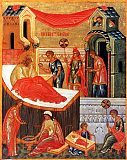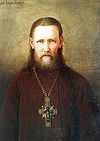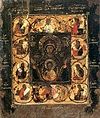

| Previous day | Next day |
| Old Style
September 8
|
Friday |
New Style
September 21
|
| 17th Week after Pentecost. Tone 7. | Fish, wine and oil allowed.
|
![]() The Nativity of Our Most Holy Lady the Theotokos and Ever-Virgin Mary.
The Nativity of Our Most Holy Lady the Theotokos and Ever-Virgin Mary.
Sts. Ioane (Maisuradze), archimandrite (1957), and Giorgi- Ioane (Mkheidze), schema-archimandrite (1962), confessors, of Georgia. St. Serapion, monk of Spaso-Eleazar Monastery (Pskov) (1481). St. Lucian, abbot, of Alexandrov (1654).
New Martyr Alexander Jacobson, at Solovki (1930).
Icons of the Most Holy Theotokos: Syamsk (1524), Glinsk (16th c.), Lukianov (16th c.), and Isaakov (1659). Icons of the Most Holy Theotokos: “Kursk Root” (1295), Pochaev (1559), Domnitsk (1696), Kholmsk (1st c.), and Lesna (1696).
St. Ina, King of Wessex, and his wife Queen Ethelburga (8th c.). New Martyr Athanasius of Thessalonica (1774). St. Sophronius of Achtalea in Georgia, bishop (1803).
Repose of Archbishop Dionysius of Ufa (1896), Elder Daniel of Katounakia, Mt. Athos (1929), and Priest Dimitrie Bejan of Romania (1995).
Thoughts for Each Day of the Year
According to the Daily Church Readings from the Word of God
By St. Theophan the Recluse

Friday. [Eph. 4:17-25; Mark 12:1-12]
In the parable about the vineyard is depicted the Old Testament Church and God’s care for it. The New Testament Church succeeded the Old, and so this parable can be applied to it as well. Since each Christian is also a living church of God, it can be applied to him as well. The latter is more needful for us. What is the vineyard? It is the soul that has received remission of sins, the grace of rebirth, the gift of the Holy Spirit as a promise of the heritage of the eternal kingdom, the word of God, the holy mysteries, a guardian angel. Who are the husbandmen? Consciousness and freedom. They receive the gifts and give a commitment to cultivate them and bear fruit to the Lord. Who are the careless husbandmen? Those who want to use the advantages of being a Christian as befits the external order of their lives, but do not bring worthy spiritual fruits to the Lord. Who are those sent from the Lord? The conscience and the fear of God, the word of God, teachers and pastors by whom the Lord wants to give understanding to the careless. Those who do not want to change themselves do not heed them; some drive them away and try to muffle their voice. Others even start to war against the Lord Himself, when they reject faith in Him in various forms. In the end, they will be miserably destroyed (cf. Mt. 21:41).
Articles
 Icon of the Mother of God “Kursk-Root”The Kursk Root Icon of the Mother of God “Of the Sign” is one of the most ancient icons of the Russian Church. |









